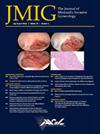良性疾病子宫切除术路径中的语言差异。
IF 3.5
2区 医学
Q1 OBSTETRICS & GYNECOLOGY
引用次数: 0
摘要
研究目的评估患者主要语言与子宫切除术途径之间的关联:利用医疗成本与利用项目的州住院患者数据库(SID)和州非住院手术与服务数据库(SASD)进行回顾性队列研究:对在 SID 和 SASD 中记录患者主要语言的六个州(印第安纳州、爱荷华州、马里兰州、密歇根州、明尼苏达州和新泽西州)最近一年(2020-2021 年)的所有住院和门诊子宫切除术进行了查询:因良性指征接受住院或门诊子宫切除术的 18 岁及以上患者:干预措施:微创子宫切除术与腹部子宫切除术的比较:评估了患者主要语言(英语与非英语)与子宫切除术途径(腹部与微创)之间的关联。研究对象包括 52,226 名符合纳入标准的患者。大多数患者为非西班牙裔白人(71%),中位年龄为 46 岁(IQR 40.0-53.0)。91.4%的患者以英语为主要语言,3.6%的患者以西班牙语为主要语言,5.0%的患者以其他非英语语言为主要语言。与讲英语的患者相比,主要语言为非英语的患者接受微创子宫切除术的几率明显较低(OR 0.60,95% CI 0.56-0.64,p结论:与讲英语的患者相比,主要语言为非英语的患者接受微创子宫切除术的几率明显较低(OR 0.60,95% CI 0.56-0.64,p结论):非英语患者接受微创子宫切除术的几率明显较低。解决语言差异可能会改善妇科患者接受微创手术的机会,而微创手术可能是改善手术效果的代名词。本文章由计算机程序翻译,如有差异,请以英文原文为准。
Language-Based Disparities in Route of Hysterectomy for Benign Disease
Study Objective
To assess the association between patient primary language and route of hysterectomy.
Design
A retrospective cohort study was conducted using the Healthcare Cost and Utilization Project's State Inpatient Database (SID) and State Ambulatory Surgery and Services Database (SASD).
Setting
All inpatient and outpatient hysterectomies from the most recent year of available data (2020–2021) from the six states that record patient primary language in the SID and SASD (Indiana, Iowa, Maryland, Michigan, Minnesota, and New Jersey) were queried.
Patients or Participants
Patients aged 18 and over undergoing an inpatient or ambulatory hysterectomy for benign indication.
Interventions
Minimally invasive hysterectomy compared to abdominal hysterectomy.
Measurement and Main Results
The association between patient primary language (English vs. non-English) and route of hysterectomy (abdominal vs minimally invasive) was evaluated. The cohort included 52,226 patients who met inclusion criteria. The majority of patients were non-Hispanic White (71%), with a median age of 46 years (IQR 40.0–53.0). 91.4% of patients spoke English as their primary language, 3.6% spoke Spanish, and 5.0% spoke another non-English language. Patients with a non-English primary language were significantly less likely to undergo minimally invasive hysterectomy compared to patients who spoke English (OR 0.60, 95% CI 0.56–0.64, p <.001). This association remained significant following adjustments for age, race, insurance, median income, state, and fibroid, abnormal uterine bleeding, prolapse or endometriosis diagnosis (aOR 0.77, 95% CI 0.71–0.84). In a sensitivity analysis of English vs Spanish vs other non-English language, the association remained significant for other non-English languages (aOR 0.67, 95% CI 0.60–0.75) but not for Spanish (aOR 0.95, 95% CI 0.83–1.09).
Conclusion
Patients who are non-English speaking are significantly less likely to receive a minimally invasive hysterectomy. Addressing language disparities may improve access to a minimally invasive route of surgery, a possible surrogate for improved surgical outcomes, for our gynecologic patients.
求助全文
通过发布文献求助,成功后即可免费获取论文全文。
去求助
来源期刊
CiteScore
5.00
自引率
7.30%
发文量
272
审稿时长
37 days
期刊介绍:
The Journal of Minimally Invasive Gynecology, formerly titled The Journal of the American Association of Gynecologic Laparoscopists, is an international clinical forum for the exchange and dissemination of ideas, findings and techniques relevant to gynecologic endoscopy and other minimally invasive procedures. The Journal, which presents research, clinical opinions and case reports from the brightest minds in gynecologic surgery, is an authoritative source informing practicing physicians of the latest, cutting-edge developments occurring in this emerging field.

 求助内容:
求助内容: 应助结果提醒方式:
应助结果提醒方式:


